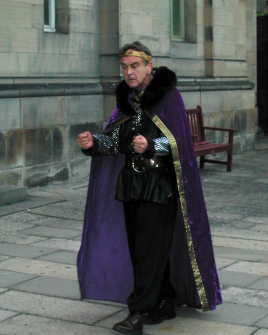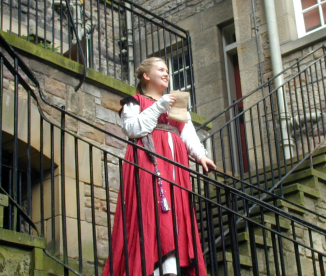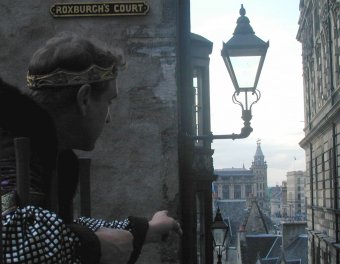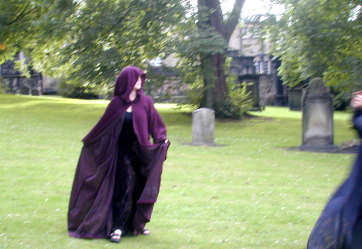Summary 
A wonderful concept lacking in execution: a Scottish company presents a mobile Macbeth outdoors along the Royal Mile on Edinburgh side streets, the action moving quickly from location to location. Undeniably fun and authentic, but the bare-bones budget and weak ensemble - almost all the supporting performances are sub-par - ultimately disappoint.
Design
Directed by Mark Erson. Costumes by Gail Lehtinen.
Cast

Simon Tait (Macbeth), Jodie Campbell (Lady Macbeth), James Yule (Head Witch), Alistair Ritchie (Banquo), Martin Heller (Duncan), Sam Henghan (MacDuff), Paul Murray (Malcolm).
Analysis
Frantic Redhead Productions presents another sold-out season of Macbeth at the Edinburgh Fringe Festival. Performers guide audiences of about seventy-five on a one-hour-forty-five-minute walking tour through wynds and closes near Edinburgh Castle, enacting scenes beside a graveyard, upon steep and stony steps, within brick courtyards, and finally on the lawn behind St. Patrick's church. Actors employ hand cymbals and rapidly pound small snare drums to simulate hoof beats as they shepherd audiences down the Royal Mile and across cobblestone side streets.
The play begins within Greyfriars Kirk Yard as witches emerge - "fair is foul, and foul is fair" - from among gravestones behind the audience. The witches, clad in hooded burgundy robes, wave the sides of their garments like wings as they dance into and among the audience. The women wield a dagger to smear the face of the ubiquitous Head Witch with stage blood, then remove their hoods to "vanish" within the crowd.

American director Mark Erson, who in the last two seasons played Ross for the company, keeps the action moving, reducing scenes to brief but effective vignettes. With cries of "to Inverness!" the audience shifts to a courtyard in front of iron-railed steps for Lady Macbeth's 1.5 poring over her husband's letter. Macbeth arrives, wide-eyed and distraught, and as he paces the courtyard, talking to both himself and his wife, the audience shifts between him and Lady Macbeth, physically moving back and forth like the contentions in their debate over the assassination of Duncan. When Macbeth finally relents, he seems to seek courage in kissing his ambitious wife.
After the off-stage execution of Duncan, spectators witness Macbeth's coronation from stone steps, appropriately looking down upon a shell-shocked Simon Tait as the new King is enrobed in black-fringed purple - similar to the witches - and crowned. Performers usher the audience away with shouts of "to the banquet!" as brief interludes depict Macbeth's 3.1 enlistment of two murderers in a murky alley and the brutal 3.3 stabbing of Banquo in a narrow passageway. Spectators, hurried with shouts to "follow the King," receive warnings that "the food is getting cold." Subsequent scenes involve Malcolm - "to England!" - as performers exhort the audience to beware Macbeth's spies - "be watchful" - and to hurry to avoid "ambush."

The setting contributes mightily to the spirit of the play, with an earnest Malcom delivering his 4.3 patriotism amid cries from overhead seagulls, and Lady Macbeth's 5.1 somnambulant guilt - "what's done cannot be undone" - garners richened audience sympathy when children in the audience are given encouragement to follow and "look after her." Malcolm and Macduff's return in force - with battle cries of "to Burnham!" - includes actors gathering branches and foliage to disguise themselves as the moving wood.
Erson's use of the Head Witch provides the production's most insightful moments. The bald and often cackling Head Witch, deeply embedded within Macbeth's scorpioned psyche, doubles in multiple roles. The Witch is the bloodied 1.2 Captain, extolling Macbeth's battlefield exploits to Duncan; the drunken porter in 2.3, staggering amid loud drum beats that represent Macduff and Lennox's knocking at the gate; the mysterious third murderer in 3.3, angry with the escape of Fleance up a flight of stairs and through the audience; and the servile Seton in 5.5, Macbeth's right-hand man who arms the beleaguered King for the final battle.
The creepy Head Witch dominates the action: he closes an iron alley gate upon Macbeth to physically isolate him as well as sever him from accession in 1.4; and he taunts Macbeth with a "dagger of the mind" in 2.4, offering a knife just beyond reach to lead the grasping thane toward the passageway where Duncan sleeps. Also, the Head Witch holds the crown aloft over the kneeling Macbeth in 3.1, and he portrays the unnamed Servant who brings the eventual murderers of Banquo to the King's presence.
Tait's Macbeth, honorable but ambitious at the outset, becomes aghast and tormented after the murder, and he makes a convincing descent into a ruthless tyrant. With a terrific - and genuine - Scottish accent, Tait's Macbeth slouches and wearies as the play progresses, and the actor overcomes wind, milling spectators, and ample Edinburgh street noise to depict the bloody-sceptred despot. Leaning over an iron railing at Roxburgh's Court, he seethes with desperation from above as the witches brew their "hell broth" for him within a stone stairwell below.

The finale, with the audience observing from behind the walls of a brick landing to the rear of St. Patrick's church, takes place on a rolling grass lawn. Macbeth's hubris, a one-handed defeat of a heavily-armored Siward, gives way to fear then defiance - "lay on, Macduff" - as the play concludes. Donalbain, a less-than-active participant in the overthrow of the cruel Macbeth, silently watches as his brother is heralded as the new King. The witches soon swarm around Donalbain like purple devils, and the insinuation that ambition and jealousy will again lead to bloodshed provides a haunting conclusion.
Frantic Redhead Productions, named after energetic and red-haired producer Ginger Perkins, have created a compact and often clever rendition of the Scottish play, performed nearly "on-location," and justifiably established as a standard for Edinburgh's annual Fringe Festival.
Note: A version of this article was edited and published in Shakespeare Bulletin, Vol.19, No.1, Winter 2001.
Photos © Justin Shaltz 2000